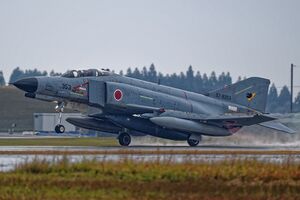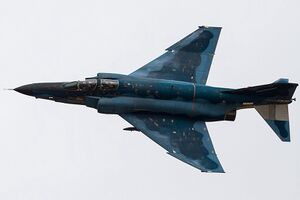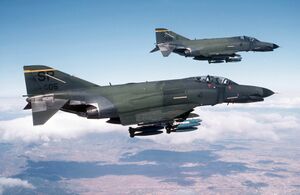JA-9 Lycan: Difference between revisions
No edit summary |
No edit summary |
||
| Line 26: | Line 26: | ||
|} | |} | ||
The '''Norderstedt JA-9 Lycan''' is a two-seat, twin-engined multirole fighter designed by Norderstedt Avia GmbH of Acrea, and adapted with Tionscail Ríoga Aeraspáis of Ossoria to meet Ossorian requirements as part of the joint ''Flygsystem 60'' project. First entering service in 1961, the Lycan has a long and storied career serving as a part of the multiple air fleets for over half a century | The '''Norderstedt JA-9 Lycan''' is a two-seat, twin-engined multirole fighter designed by Norderstedt Avia GmbH of Acrea, and adapted with Tionscail Ríoga Aeraspáis of Ossoria to meet Ossorian requirements as part of the joint ''Flygsystem 60'' project. First entering service in 1961, the Lycan has a long and storied career serving as a part of the multiple air fleets for over half a century. Initially designed to serve the role of a coastal and fleet defence interceptor, the airframe proved incredibly adaptable and would eventually go on to perform nearly every tactical role available in Acrean naval aviation. Different variants in Acrean service proved capable of performing air superiority, strike, tactical and strategic bombing, reconnaissance, SEAD, and interception missions. The Lycan was the first fighter in Acrean service to receive an official name derived from unofficial names given to it by its aircrews; it is so named because of the distinctive shape of the nose of the aircraft which resembled a wolf or a fox. | ||
Although it began its service life in 1960, constant upgrades to the Lycan's peripheral and core systems, avionics, airframe, and powerplants kept it competitive with many newly produced fighters throughout the 20th Century. A major overhaul in the mid-1970s resulted in the JA-9S, featuring new engines, airframe refit and redesigns, and avionics. This variant was the first aircraft in Acrean service to be capable of supercruise. Low operating costs, a large number of airframes, ruggedness, and a incredibly positive public reputation created by its performance in combat operations gave the Lycan a near-legendary status within Acrean aviation. | Although it began its service life in 1960, constant upgrades to the Lycan's peripheral and core systems, avionics, airframe, and powerplants kept it competitive with many newly produced fighters throughout the 20th Century. A major overhaul in the mid-1970s resulted in the JA-9S, featuring new engines, airframe refit and redesigns, and avionics. This variant was the first aircraft in Acrean service to be capable of supercruise. Low operating costs, a large number of airframes, ruggedness, and a incredibly positive public reputation created by its performance in combat operations gave the Lycan a near-legendary status within Acrean aviation. All Lycans in Acrean service were retired by 1996. The Lycan has seen considerable use in a number of other air forces, including that of [[Shalum]] and, notably, [[Gylias]]. Sales of retired Acrean Lycans to the [[Gylian Self-Defense Forces|GASDF]] marked one of the first transfers of advanced military equipment to Gylias. | ||
==Development== | ==Development== | ||
Revision as of 15:57, 19 July 2023
| JA-9 Lycan | |
|---|---|

| |
| Acrean Navy JA-9S in 1985 | |
| Role | Multirole fighter |
| National origin | |
| Manufacturer | Vogt GmbH |
| First flight | 1958 |
| Introduction | 1961 |
| Retired | 1996 (Acrea) |
| Status | In service |
| Primary user | |
| Produced | 1960-1971 |
The Norderstedt JA-9 Lycan is a two-seat, twin-engined multirole fighter designed by Norderstedt Avia GmbH of Acrea, and adapted with Tionscail Ríoga Aeraspáis of Ossoria to meet Ossorian requirements as part of the joint Flygsystem 60 project. First entering service in 1961, the Lycan has a long and storied career serving as a part of the multiple air fleets for over half a century. Initially designed to serve the role of a coastal and fleet defence interceptor, the airframe proved incredibly adaptable and would eventually go on to perform nearly every tactical role available in Acrean naval aviation. Different variants in Acrean service proved capable of performing air superiority, strike, tactical and strategic bombing, reconnaissance, SEAD, and interception missions. The Lycan was the first fighter in Acrean service to receive an official name derived from unofficial names given to it by its aircrews; it is so named because of the distinctive shape of the nose of the aircraft which resembled a wolf or a fox.
Although it began its service life in 1960, constant upgrades to the Lycan's peripheral and core systems, avionics, airframe, and powerplants kept it competitive with many newly produced fighters throughout the 20th Century. A major overhaul in the mid-1970s resulted in the JA-9S, featuring new engines, airframe refit and redesigns, and avionics. This variant was the first aircraft in Acrean service to be capable of supercruise. Low operating costs, a large number of airframes, ruggedness, and a incredibly positive public reputation created by its performance in combat operations gave the Lycan a near-legendary status within Acrean aviation. All Lycans in Acrean service were retired by 1996. The Lycan has seen considerable use in a number of other air forces, including that of Shalum and, notably, Gylias. Sales of retired Acrean Lycans to the GASDF marked one of the first transfers of advanced military equipment to Gylias.
Development
Post-Great War arms buildups by Aethurheim, Svinia, and Cacerta put the need for new frontline combat aircraft into focus for the Acrean Air Force. Although the Air Force had successfully developed and employed several series of jet fighters throughout the 1950s, including the cantilevered delta-wing EF-105 which was the first true supersonic fighter in Acrean service, the air arm of the Acrean Navy had been left behind. The desire to take advantage of developments in propulsion, and the need for an aircraft designed to be naval capable from the start, led to the JA-9 being developed primarily by the Acrean Navy.
Design
The JA-9 is a two-seat fighter including advanced pulse-doppler radar and extensive use of titanium. The JA-9 was originally fitted with twin MD EJ-110 afterburning turbofans, combined providing 160kn of thrust in afterburner which could propel the aircraft to a speed of Mach 2.2 at altitude. It was capable of carrying 9,000 kg of ordnance on ten external hardpoints, including mixed loads of air-air missile, external fuel tanks, and ground attack munitions.
Early Upgrades
Major Overhauls
The solution for a major upgrade package for the Lycan in the mid-1970s came from a design committee formed by engineers from both Norderstedt and MDA, Acrea's major military aerospace firms. It included a major overhaul of numerous parts of the aircraft. The engines were completely replaced by new EJ-815 afterburning turbofans, a derivative of the engine which was due to power the future EF-161 Raven and which was much lighter and more powerful than the engines which powered the existing fleet of aircraft. The new engines combined provided over 180kn of thrust in afterburner, and nearly 128kn of dry thrust. In addition to improving the already impressive acceleration of the JA-9 by a third, the engines also drastically increased the climb rate of the aircraft while proving more fuel efficient than the older turbojets. Crucially, they allowed the jet to supercruise, something particularly appealing to range-minded naval aviators. The flaps and leading edge slats on the aircraft were redesigned, which combined with wing strakes allowed the aircraft to pull higher AOA and higher-G turns.
Combined with serious rebuilds of the airframes to renew them for an extended service life that also included further weight reduction, the newly refitted fighters were faster and uncharacteristically agile for what had gained a reputation as a heavyweight fighter who relied on speed. Avionics improvements were almost entirely drawn from the EF/A-121, and were almost completely copied over to the new Lycans. Cockpit displays were changed to digital displays, the radars received substantial improvements, and with the full refit the newly designated S-series fighters were the avionic equivalent
Operational History
The JA-9 is best known for its extensive use in the Refusal War. They served a variety of roles, most often as missile trucks or intercept cover for EF/A-121 SEAD packages, providing close air support using air-to-ground missiles, or conducting tactical bombing missions. Although longer in the tooth compared to other Acrean aircraft deployed in operations in Siduri, the Lycan gained a distinct reputation for its ruggedness. JA-9 squadrons flying close-support and strike missions would frequently fly into areas considered unsuitable for other aircraft due to AAA intensity, and would be able to complete their missions and return to their airfields despite regularly suffer significant damage. Such events include one recorded instance of an aircraft receiving a burst of anti-aircraft shells which pierced the fuselage, detonated within the engine intake, but continued to fly normally with both engines operational. The Lycan's retention in service came as the result largely of political inertia, guided by a combination of low operating costs, large number of airframes, ruggedness, and a public reputation created by its performance in operations over Syara and in the years afterwards.
Variants
- T-26 Gaoth: Licensed variant built by Tionscail Ríoga Aeraspáis for the Royal Ossorian Navy and Royal Ossorian Air Force.
Operators
Former Operators
Specifications (JA-9S)
General Characteristics
- Crew: 2
- Length:
- Wingspan:
- Height:
- Wing Area:
- Empty Weight:
- Fuel Capacity:
- Powerplant:
Performance
- Maximum Speed: Mach 2.2 at altitude
- Mach 1.25 at sea level
- Mach 1.3 supercruise at altitude
- Service Ceiling: 20,000 m
Armament
- Guns: 1 x 20mm revolver cannon with 640 rounds
- Payload: 10 external hardpoints with a capacity of up to 9,000 kg
See Also
- Aircraft of Comparable Role, Configuration, and Era


